When creating unique tea blends, you'll find endless possibilities by pairing complementary flavors. Try combining Earl Grey with lavender for a floral twist, or mix green tea with citrus fruits for a invigorating kick. Experiment with unexpected combinations like smoky Lapsang Souchong and cool peppermint, or earthy pu-erh with creamy coconut. Don't shy away from adding spices like cinnamon, ginger, or star anise to your favorite black or herbal teas. For seasonal inspiration, incorporate dried fruits or warm spices in autumn blends. By exploring diverse flavor profiles and thinking outside the box, you'll discover exciting new tea experiences that tantalize your taste buds.
Classic Tea Flavor Combinations
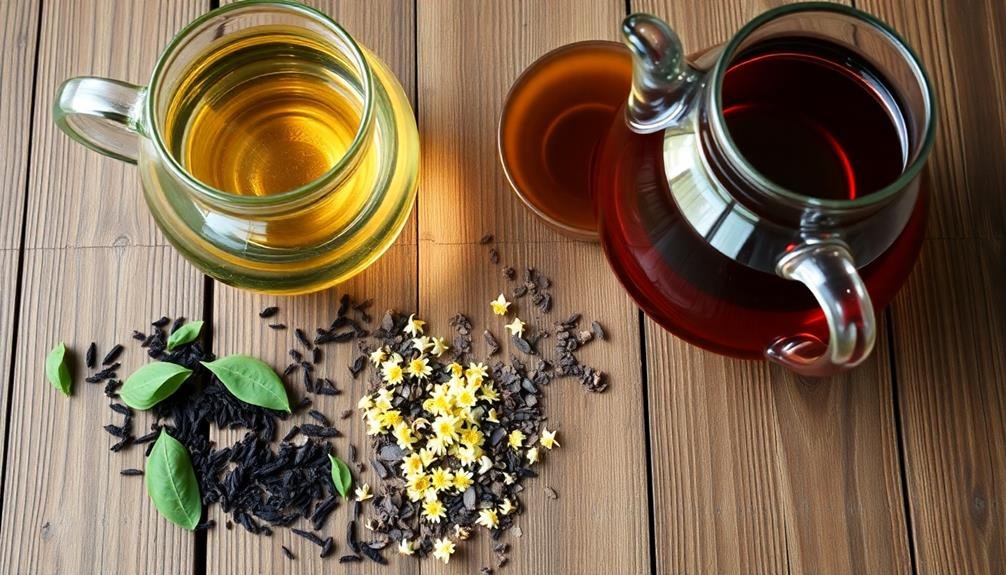
While many tea enthusiasts enjoy single-origin brews, classic flavor combinations have stood the test of time for good reason.
These tried-and-true pairings offer a harmonious balance of tastes that can elevate your tea-drinking experience. One popular combination is Earl Grey with lavender, which adds a floral note to the bergamot-infused black tea. You'll find the aromatic blend both soothing and energizing.
For a fruity twist, consider pairing green tea with lemon or lime. The citrus notes complement the grassy flavor of green tea, creating a revitalizing and zesty drink.
If you're looking for something more indulgent, try blending chai spices with vanilla. This combination offers a rich, creamy taste that's perfect for cooler days.
Mint and chamomile make another classic pairing, offering a calming blend that's ideal for evening relaxation.
For a more robust flavor profile, combine Assam black tea with cinnamon and orange peel. This spicy-sweet combination provides a warming cup that's perfect for cold mornings.
These classic tea flavor combinations serve as excellent starting points for creating your own unique blends.
Herbal and Floral Pairings
Beyond traditional tea leaves, herbal and floral ingredients offer a world of exciting flavor possibilities. You'll find that combining these elements can create unique blends that tantalize your taste buds and offer potential health benefits.
Start with chamomile as a base and add lavender for a soothing, sleep-inducing blend. Or, pair peppermint with lemongrass for an invigorating, digestive-friendly infusion. Hibiscus flowers provide a tart, fruity flavor that works well with rosehips, creating a vitamin C-rich blend.
For a spicy kick, mix ginger with licorice root. This combination not only tastes great but may also help soothe sore throats.
Experiment with rooibos as a caffeine-free base, adding vanilla and cinnamon for a dessert-like treat.
Don't forget about floral notes like jasmine, which pairs beautifully with green tea or oolong. Rose petals can add a delicate sweetness to black tea or herbal blends.
For a unique twist, try blending chrysanthemum with honeysuckle for a light, sweet infusion.
Fruity Tea Blend Ideas
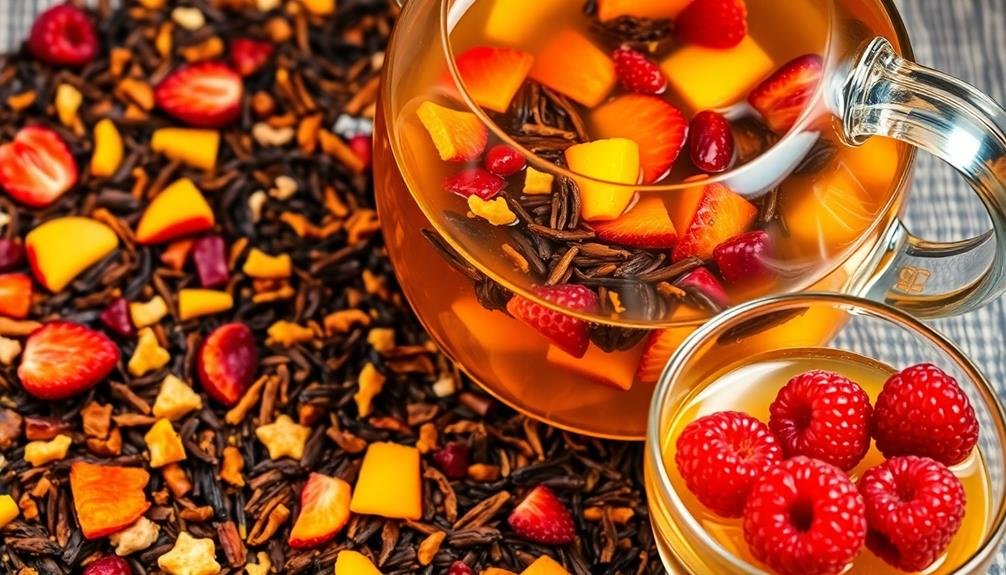
Infusing tea with fruity flavors can transform your ordinary cup into an extraordinary sensory experience. You'll find that certain fruit and tea combinations create harmonious blends that tantalize your taste buds.
For a revitalizing twist, try pairing green tea with citrus fruits like lemon, lime, or orange. The bright, zesty notes complement the tea's grassy undertones perfectly.
If you're a fan of black tea, consider blending it with berries. Strawberry, raspberry, or blueberry can add a sweet-tart dimension that balances the tea's robust flavor.
For a tropical escape, mix white tea with mango or pineapple. The delicate tea base allows the fruit's natural sweetness to shine through.
Don't forget about stone fruits! Peach and apricot pair wonderfully with oolong tea, creating a smooth, mellow blend.
For a unique combination, try mixing rooibos with pomegranate or fig. These rich, complex fruits enhance the tea's nutty notes.
Experiment with dried fruits too; they can infuse your tea with intense flavors without adding extra liquid.
Spice-Infused Tea Mixtures
Spices offer another dimension to tea blending, taking your cup from fruity to warm and aromatic. When creating spice-infused tea mixtures, you'll want to reflect on the intensity and complementary flavors of each spice.
Cinnamon pairs well with black teas, adding a sweet and woody note. For a more complex flavor, try combining cinnamon with cardamom and ginger in a chai-inspired blend.
Ginger adds a zesty kick to green teas and can be balanced with a touch of lemongrass for a revitalizing twist. If you're looking for a soothing blend, chamomile tea works wonderfully with a pinch of nutmeg or vanilla.
For a bolder taste, experiment with star anise or cloves in your black tea base.
Don't forget about savory spices like turmeric or black pepper. These can add depth to herbal blends and offer potential health benefits.
When working with spices, start with small amounts and adjust to taste. Remember that some spices, like cinnamon and clove, can be overpowering if used in excess.
Seasonal Tea Blending Inspirations
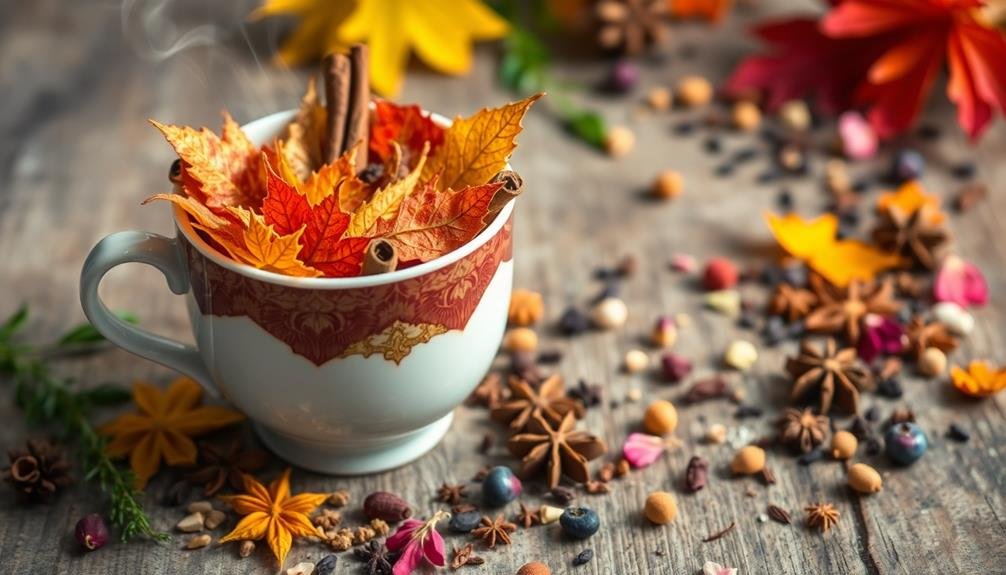
As you explore seasonal tea blending, you'll find inspiration in nature's changing palette.
For spring, try combining delicate floral notes like lavender or jasmine with light green teas.
When autumn arrives, create cozy blends by mixing warm spices such as cinnamon and nutmeg with robust black teas.
Spring-Inspired Floral Combinations
Spring's arrival brings a wealth of floral flavors perfect for creating unique tea blends. You'll find an array of delicate and aromatic options to experiment with, from classic choices like jasmine and rose to more adventurous picks like lavender and elderflower. When crafting your spring-inspired tea blends, consider balancing the floral notes with lighter base teas like white or green varieties.
Try pairing chamomile with lemon verbena for a soothing blend, or mix hibiscus with orange blossom for a vibrant, tangy infusion. Don't shy away from unexpected combinations – you might discover a new favorite by blending chrysanthemum with mint or adding a touch of osmanthus to your oolong.
Here's a quick guide to some spring floral tea pairings:
| Floral Ingredient | Base Tea | Complementary Flavor |
|---|---|---|
| Jasmine | Green | Peach |
| Lavender | White | Vanilla |
| Rose | Black | Raspberry |
| Elderflower | Oolong | Lemon |
| Chrysanthemum | Pu-erh | Ginger |
Remember to start with small batches and adjust proportions to suit your taste preferences. You'll soon be creating invigorating, spring-inspired blends that capture the essence of the season.
Cozy Autumn Spice Blends
When autumn leaves start to fall, it's time to embrace the warmth of cozy spice blends in your tea. Create comforting concoctions that capture the essence of the season by combining rich black teas with aromatic spices. Start with a robust Assam or Ceylon as your base, then add warming elements like cinnamon, ginger, and cardamom.
For a classic autumn blend, mix black tea with cinnamon chips, dried apple pieces, and a touch of clove. This combination evokes memories of apple pie and crisp fall days.
If you're feeling adventurous, try incorporating roasted mate for a smoky flavor that pairs well with nutmeg and allspice.
Don't forget about the sweetness of the season. Add dried cranberries or orange peel to your spice blend for a burst of fruity flavor.
For a dessert-like experience, experiment with vanilla bean or cacao nibs. These ingredients complement the spices and create an indulgent treat.
Remember to balance your blend carefully. Too many strong spices can overpower the tea's natural flavor. Start with small amounts and adjust to your taste preferences.
With these autumn-inspired combinations, you'll create the perfect cup to warm you on chilly days.
Unexpected Tea Flavor Marriages
Tea blending aficionados are always on the lookout for unexpected flavor combinations that can create truly unique and memorable brews.
You'll be surprised at how well certain contrasting flavors can complement each other, resulting in exciting new taste experiences. When experimenting with unconventional pairings, consider combining teas with different flavor profiles, such as sweet and savory or floral and earthy.
Here are four unexpected tea flavor marriages to inspire your blending adventures:
- Lapsang Souchong and Peppermint: The smoky notes of Lapsang Souchong blend surprisingly well with the cool, invigorating taste of peppermint.
- Matcha and Lavender: The grassy, umami flavor of matcha is beautifully balanced by the delicate floral notes of lavender.
- Pu-erh and Coconut: The earthy, rich taste of pu-erh tea pairs unexpectedly well with the creamy sweetness of coconut.
- Chamomile and Lemongrass: The soothing, apple-like flavor of chamomile is enhanced by the bright, citrusy notes of lemongrass.
Don't be afraid to push the boundaries of traditional tea blending.
Frequently Asked Questions
How Long Should I Steep Blended Teas Compared to Single-Flavor Teas?
You'll typically steep blended teas for the same duration as single-flavor teas, about 2-5 minutes. However, you should adjust steeping time based on the specific blend's ingredients and your taste preferences. Always follow package instructions when available.
Can I Blend Different Types of Tea Bases Together?
Yes, you can blend different tea bases together. It's a great way to create unique flavors. Try mixing black and green teas, or oolong with white tea. You'll discover exciting new combinations that suit your taste preferences.
What's the Best Way to Store Homemade Tea Blends?
Store your homemade tea blends in airtight containers away from light, heat, and moisture. You'll want to keep them in a cool, dark place. Don't forget to label each blend with its ingredients and the date you made it.
Are There Any Tea Flavors That Should Never Be Mixed Together?
You'll generally want to avoid mixing strong, conflicting flavors like mint with citrus or chai spices. It's best to steer clear of combining delicate green teas with robust black teas. Trust your taste buds and experiment cautiously.
How Can I Adjust the Strength of Individual Flavors in a Blend?
You can adjust flavor strength in a blend by altering the ratio of ingredients. Use more of a tea for a stronger taste, or less for subtlety. Steep time and temperature also affect intensity. Experiment to find your perfect balance.
In Summary
You've now explored a world of tea blending possibilities. From classic combinations to unexpected pairings, you're equipped to create your own unique blends. Don't be afraid to experiment with different flavors, herbs, fruits, and spices. Trust your palate and let your creativity guide you. Remember, there's no right or wrong in tea blending – it's all about finding what you love. So, grab your favorite teas and start mixing. Your perfect blend awaits!

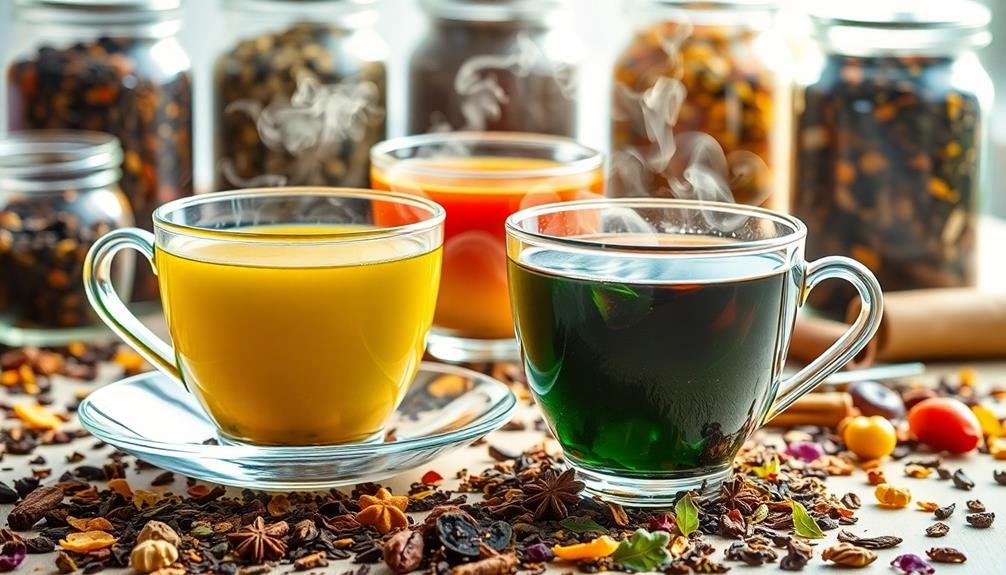
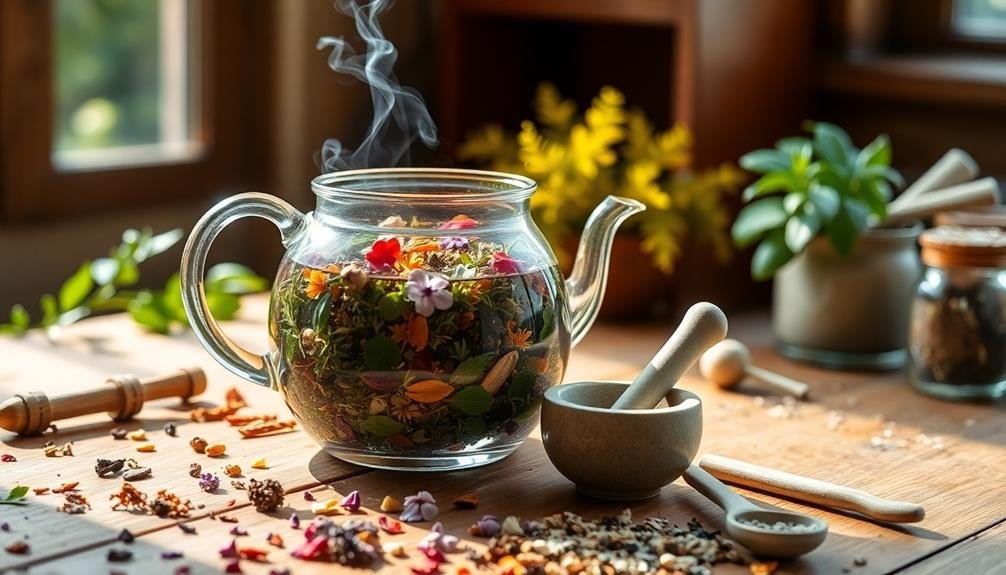
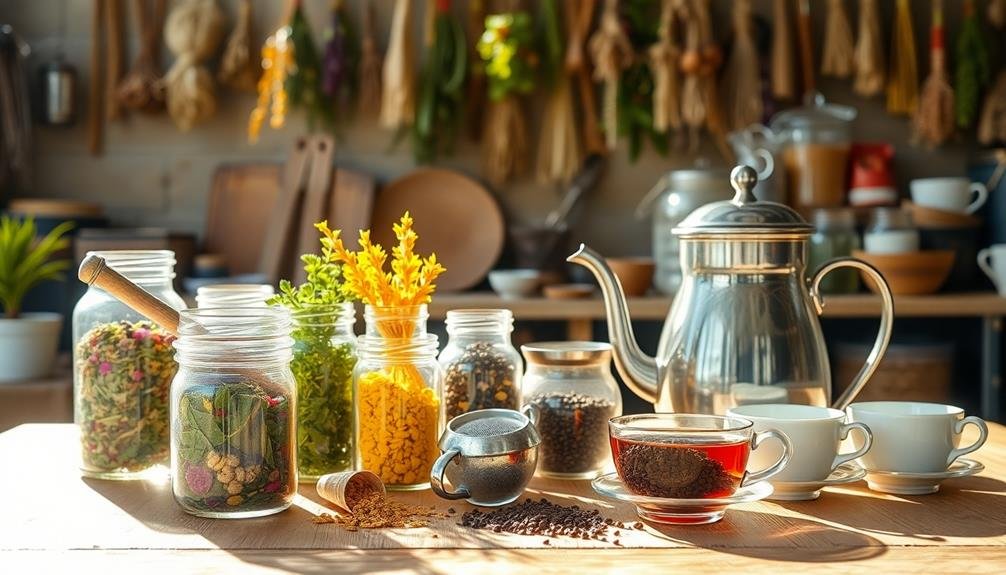
Leave a Reply